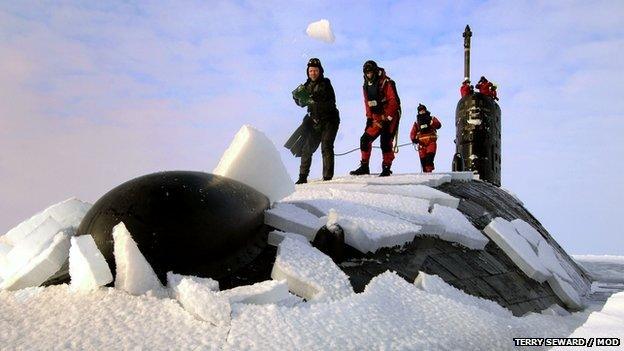UK submarine data de-classified to aid climate science
- Published

Environmental data is routinely collected by submarines and other Navy vessels
The UK Ministry of Defence is to de-classify submarine data to help shed light on climate change in the Arctic.
Environmental data are routinely monitored by Navy vessels, but the measurements are highly sensitive because they could give away positions.
A dataset from one submarine mission will be released to give a snapshot of conditions under the ice.
It is hoped that further data could be released in future, yielding clues to how the Arctic is changing.
Water temperature and salt content are among the environmental data monitored by submarines.
But only a handful of people have access to such information because they could be used to track where UK submarines go.
As part of the Submarine Estimates of Arctic Turbulence Spectra (SEATS) project, the MoD will release measurements to researchers at the National Oceanography Centre (NOC) in Southampton.
NOC scientist John Allen said that, although the exact positions where readings were taken would remain classified, if measurements were given generic classifications they could be used to study physical attributes of the ocean.
"If you look at a trace of temperature, you can see it wobbling around. But within that there will be particular length scales at which it wobbles," he told BBC News.
"What we can do is to look at whether that changes depending on whether you are under ice or under open water."
Improved product
This, he explained, could tell scientists a lot about how the Arctic is likely to change as it becomes more seasonally ice-free.
Last year, Arctic sea ice shrank to its second-lowest level since satellite records began.
Some computer models forecast that the Arctic could be completely clear of summer sea ice within a decade, though others recently published say there may be high years and low years en route to the final disappearance.
The UK's Defence Science and Technology Laboratory (DSTL) has been working with the Natural Environment Research Council (Nerc) and the UK Hydrographic Office (UKHO) to prepare the data for use by NOC scientists.
Tim Clarke, a marine scientist with DSTL, said: "What this represents is the availability of important scientific data, previously inaccessible, which can only move the study forward.
He added that "any progress will, ultimately, lead to an improved oceanographic product" for the Royal Navy.
Dr Allen confirmed that techniques developed on this project would also feed back into naval operations, where understanding the ocean environment is vital.
Scientists have previously made trips under the Arctic aboard nuclear submarines in order to measure ice thickness.
But these were dedicated scientific missions; environmental data collected as part of standard Navy operations have rarely been released.
Historically, the sea ice has been used as cover by submarines to evade detection by surface ships or aircraft. And during the Cold War, the Arctic became a key area for submarine operations in aid of strategic defence.
Paul.Rincon-INTERNET@bbc.co.uk
- Published21 September 2011
- Published16 September 2011
- Published31 August 2011
- Published25 August 2011
- Published8 April 2011